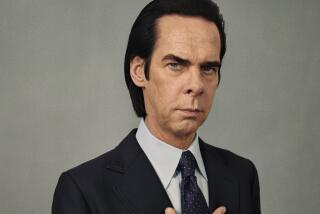A Rebel’s Verse : The Doors’ Jim Morrison made his mark as a rocker, but 20 years after his death it is his poetry that is attracting new attention.
Since his death in 1971 at age 27, Jim Morrison has come to signify the glory and the decadence of the ‘60s saga of sex, drugs and rock ‘n’ roll. But beyond the hedonism and beyond the music, the Doors’ lead singer had another side. Morrison wanted to be a poet--not just the writer of many of the song lyrics that were a Doors signature, but of serious verse.
In a 1969 interview with Jerry Hopkins in Rolling Stone, Morrison called poetry “eternal.” “Nothing else can survive a holocaust but poetry and songs,” he said. “No one can remember an entire novel. No one can describe a film or a piece of sculpture, a painting. But so long as there are human beings, songs and poetry can continue.”
And indeed, Morrison’s poetry has continued, although his literary legacy is a small part of the image that is still potent this year, the 20th anniversary of his death: His baritone haunts the airwaves and his pouty image stares from magazine covers, posters, T-shirts--even the side of a three-story building at Venice beach. He is also the subject of the recently released film, “The Doors,” directed by Oliver Stone, and of at least half a dozen new books. (See accompanying story.)
Meanwhile, Morrison’s poetry has been attracting its own fans, not just a cult following, but a cadre of scholars who have come to regard him as one of the major poets of his generation, even the century.
Some may scoff, but poet Michael McClure--whose own writings linked the ‘50s “beat” generation with the ‘60s “flower power” generation, says, Morrison’s poetry “will be in the canon of the era.”
He was “the major poet of the last quarter of the 20th Century,” says Maria Rosa Menocal, an associate professor of Medieval literature at Yale. She is at work on a review of Morrison’s posthumously published poetry.
And Wallace Fowlie, an 82-year-old professor emeritus of French at Duke University, lectures on Morrison around the country. He has found parallels between Morrison and 19th-Century French poet Arthur Rimbaud, seeing both as “the rebel as artist.”
During his lifetime, some of Morrison’s works were published privately, and then in a single commercial volume. After his death, Morrison’s common-law wife, Pamela Courson, attempted to get other works published. When she died, her parents inherited the rights to Morrison’s works and continued her quest.
As a result, “Wilderness: The Lost Writings of Jim Morrison, Volume I,” was published in 1989 by Villard Books. There have been three printings, totaling 151,000 copies and 100,000 copies of a 1990 paperback edition from Vintage Press.
“The American Night: The Writings of Jim Morrison, Volume II,” was published in 1990 with a first printing of 95,000 copies. “That’s an extraordinary number,” says Peter Gethers, publisher/editorial director of Villard. He says that a printing of 5,000 to 7,500 copies is considered huge for a poetry volume. As to why Morrison’s poetry is the exception, Gethers offers, “Well, he is Jim Morrison. And his writings do seem to define an era.”
The son of a Navy rear admiral, Morrison was born in Melbourne, Fla., on Dec. 8, 1943.
As a child, he read exhaustively. He was about 10 when he wrote his first poem, “The Pony Express.” “It was one of those ballad type poems,” he once recalled, adding, “I never could get it together, though.”
Morrison attended UCLA, where he dropped out in 1965 shortly before graduation. That summer he ran into classmate Ray Manzarek at Venice Beach and sang for him the lyrics he’d written for a song called “Moonlight Drive.” It was then that the two decided to form a band, which went on to include guitarist Robby Krieger and drummer John Densmore.
Singled out by the press as the Doors’ pretty boy star, Morrison also stood out as an intellectual. He read and quoted the 19th-Century French poets Arthur Rimbaud and Charles Baudelaire, as well as the German philosopher, Friedrich Nietzsche.
Some say that toward the end of the Doors’ four-year rise and fall--around the time of a notorious 1969 concert in Miami during which he was arrested for indecent exposure--Morrison felt he was a poet trapped in his self-created image as the most outrageous, on-the-edge rock star of his time, his behavior fueled by drugs and later alcohol.
Doors fans did not embrace Morrison the poet. Critics and audiences alike accused him of pretentious posturings.
When the Doors performed at the Aquarius Theater on the Sunset Strip in July, 1969, Morrison--bearded, overweight and wearing little orange glasses--read aloud a poem he’d written after the recent death of Rolling Stones guitarist Brian Jones. Copies of the poem were passed out to the crowd.
When the concert ended, the theater was littered with copies of Morrison’s “Ode to LA While Thinking of Brian Jones, Deceased”--many folded into airplanes that were flown across the auditorium.
During his rock career and mostly because of his fame, Morrison’s poems appeared in a spate of publications, including Rolling Stone, the Los Angeles Free Press and Stereo Review.
In 1968 poet/playwright Michael McClure persuaded him to privately publish his poetry. McClure says he told Morrison that this “would be a kind of trial run. Jim was worried that his poetry would be seen as the poetry of a rock ‘n’ roll star.”
Indeed, for his private printings, Morrison used his full name--James Douglas Morrison.
“The Lords: Notes on Vision” was a compilation of poems and observations, printed on parchment contained in a blue binder with tie-string. “The New Creatures,” was a 42-page booklet of poetry. Five-hundred copies of each were printed. Both are now considered collector’s items.
In 1969, the two works were combined in “The Lords and the New Creatures” published by Simon & Schuster and reprinted in 1987.
“He was thrilled by the commercial edition,” relates McClure. “He was so happy that the publisher didn’t beat the rock ‘n’ roll drums.”
However, Morrison was reportedly disappointed that the book was published under the name, Jim Morrison and used a famous pinup picture of him on the jacket. When the paperback edition was being prepared, the publisher substituted a more literary looking photograph of a bearded Morrison at his request.
After Morrison’s death, reportedly of heart failure, Pamela Courson tried to get his unpublished writings into print.
In August, 1971, she asked McClure for help. Courson gave him “a very lucidly assembled collection, maybe 150 pages,” McClure says. However, he returned the poems and told her she needed to edit them herself.
Courson died of a heroin overdose in 1974. Since her death, McClure says, no one has found the poetry Courson showed him.
Before she died, Pamela Courson was about to inherit Morrison’s estate after a long legal battle with the Doors. They claimed they were owed money from the estate, which included song royalties and related merchandising and is said to be worth more than $1 million a year.
The estate was divided between Courson’s parents, who live in Palm Desert, and Morrison’s parents, Steve and Clara Morrison, who live in the San Diego area and will not discuss the son from whom they were estranged. The profits from Morrison’s books of poetry are split between the couples. However the Coursons received control of Morrison’s manuscripts, which include large number of poems that were in their daughter’s possession when she died.
Pearl Courson says she and her husband Columbus (Corky)--a former Orange County high school principal--continued the efforts to get Morrison’s poetry published, “because this was something we felt we had to do for our daughter and for Jim. We thought of him as someone very special in her life.”
The Coursons did not involve the Doors in the posthumous publications. “Why should they be involved?” says Pearl Courson. “They had nothing to do with Jim’s poetry. They didn’t create it. They didn’t work with him on it.”
A lasting bitterness exists between the Coursons and the Doors because of their daughter’s legal difficulties with them and the publication of a paperback biography of Morrison, “No One Here Gets Out Alive.” The 1980 book describes tawdry episodes involving Morrison and Courson. Its co-author, Danny Sugerman, is now a Doors consultant.
Of Morrison’s poetry, Sugerman says, “We think it’s great (that it’s being published), but we don’t necessarily agree with the way it’s being edited.
“If the Doors were the editors and arrangers of Jim’s poetry, instead of the people who are doing it, the poetry would come closer to the greatness and timelessness of the lyrics,” Sugerman says.
Still other Morrison associates question whether Morrison writings should be posthumously published at all.
Alan Ronay, a longtime friend of Morrison’s--who recalls how Morrison used to anguish over a single word, or punctuation--sees the works as unfinished writings.
“If something was thrown in a wastebasket by Cezanne, I don’t think it should hang in a museum,” says Ronay. “What about the sanctity of the writer?”
The Coursons feel that great efforts have been made to preserve what Morrison intended. Frank and Kathy Lisciandro, who were friends and employees of Morrison and the Doors, assisted the Coursons in putting together the books of poetry. Lisciandro met Morrison at UCLA in 1964. His wife was secretary to the band.
Morrison didn’t date his works, but Lisciandro says they were ultimately able to determine the final version of poems--some of which were reworked by Morrison up to 50 times.
According to Lisciandro, “if there was any question” about a poem not being the latest draft, “it was put away and not printed.”
Morrison was near-obsessive in drawing a line between his poetry and rock lyrics. That trait bemuses Yale medievalist Maria Rosa Menocal, who says, “If he’d been writing in the 13th Century, there would have been no distinction--poets were writing for songs, as troubadours.”
As Menocal, 37, notes, there’s a sad footnote to the rise of Morrison the poet: Most bookstores put his poetry in their music sections. The books are also published under the name Jim Morrison, not James Douglas Morrison.
The reason, admits Villard’s Peter Gethers, is “they sell better.”
As perhaps do the souvenir postcards tourists buy at Morrison’s grave at Pere Lachaise cemetery in Paris, where, ironically or fittingly, “the king of orgasmic rock” lies near Moliere, Proust, Oscar Wilde and Honore de Balzac.
I’m a resident of a city They’ve just picked me to play the Prince of Denmark Poor Ophelia All those ghosts he never saw Floating to doom On an iron candle Come back, brave warrior Do the dive On another channel from “Ode to LA While Thinking of Brian Jones, Deceased” by Jim Morrison
When the still sea conspires an armor And her sullen and aborted Currents breed tiny monsters, True sailing is dead Awkward instant And the first animal is jettisoned Legs furiously pumping Their stiff green gallop, And heads bob up Poise Delicate Pause Consent In mute nostril agony Carefully refined And sealed over “Horse Latitudes” by Jim Morrison
More to Read
Sign up for our Book Club newsletter
Get the latest news, events and more from the Los Angeles Times Book Club, and help us get L.A. reading and talking.
You may occasionally receive promotional content from the Los Angeles Times.







